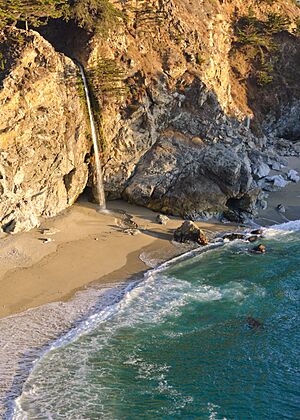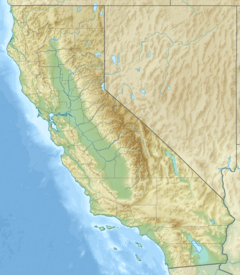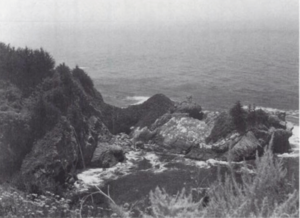McWay Falls facts for kids
Quick facts for kids McWay Falls |
|
|---|---|

McWay Falls
|
|
| Lua error in Module:Infobox_mapframe at line 185: attempt to index field 'wikibase' (a nil value). | |
| Location | Julia Pfeiffer Burns State Park, Big Sur, Monterey County, California, United States |
| Coordinates | 36°09′28.1″N 121°40′19.7″W / 36.157806°N 121.672139°W |
| Type | Plunge tidefall |
| Total height | 80 feet (24 m) |
| Number of drops | 1 |
McWay Falls is a beautiful waterfall on the coast of Big Sur in central California. It is about 80-foot-tall (24 m) and flows all year long from McWay Creek into the Pacific Ocean. You can find it inside Julia Pfeiffer Burns State Park, about 37 miles (60 km) south of Carmel.
When the ocean tide is high, McWay Falls becomes a special kind of waterfall called a tidefall. This means the water drops directly into the ocean. There is only one other tidefall in California, called Alamere Falls.
Contents
History of McWay Falls and the Park
McWay Falls is part of a special area that became a state park. Let's learn about how this land was used before it became a park for everyone to enjoy.
The Saddle Rock Ranch Story
In 1924, a rich U.S. Congressman named Lathrop Brown and his wife, Hélène Hooper Brown, visited Big Sur. They loved the area so much that they bought a large property called Saddle Rock Ranch. This ranch was about 1,600-acre (650 ha) and included a rocky point called Saddle Rock. They bought it from an early settler named Christopher McWay.
Hélène Brown was good friends with Julia Pfeiffer Burns, who was also a pioneer in the area. Julia passed away in 1928. Julia's great-niece, Esther Julia Pfeiffer, and her husband, Hans Ewoldsen, took care of the Saddle Rock Ranch for many years.
Building the Waterfall House
The Browns first built a simple cabin made of redwood wood on the cliffs across from McWay Falls. Later, in 1940, they built a fancy two-story house there called Waterfall House. The entrance of the house had cool designs made of brass, like a fish, an octopus, and a compass. Inside, the house was filled with nice furniture and classic paintings.
Early Electricity in Big Sur
While the Carmel San Simeon Highway was being built through Big Sur, the foreman of Saddle Rock Ranch, Hans Ewoldsen, helped out. He used the highway construction shop to build a special water wheel called a Pelton wheel. He used redwood from the canyon and other materials he bought.
In 1932, he put the wheel on McWay Creek. This wheel created electricity, which was the first electric power in the Big Sur area! It provided power to three homes, a metalworking shop, and even a small railway that pulled things up and down a steep hill.
Giving the Land to the State
Lathrop and Hélène Brown moved to Florida in 1956. Lathrop passed away in 1959. In 1961, Hélène Hooper Brown decided to give all of her property to the state of California. She wanted it to be used as a park and named after her good friend, Julia Pfeiffer Burns.
Hélène also asked that the Waterfall House be turned into a museum. This museum would show Native American items, plants and animals from the California coast, and historical objects from the Big Sur area. If it couldn't be a museum, she said it should be taken down.
The museum idea didn't work out because there wasn't enough money, and it was hard for people to get to the site. So, the mansion was taken down in 1965. Today, a viewing area for McWay Falls is built right where the house used to be.
How the Falls Changed Over Time
In 1983, Big Sur had a lot of rain, more than ever before! Before this, McWay Falls dropped straight into the ocean. But the heavy rain caused many landslides, where mud and rocks slid down the hills.
A very big mudslide happened just north of Julia Pfeiffer Burns State Park on March 1. This mud and dirt flowed into the ocean right next to the falls. Highway 1 was closed for a whole year while it was being fixed.
When the highway was rebuilt, nearly 3,000,000 cubic yards (2,300,000 cubic metres) of landslide material was placed on the coast. Over time, ocean waves moved some of this material south into McWay Cove. This created a sandy beach under the falls where there wasn't one before!
Loose dirt from the hillsides still adds sand to the beach. Now, McWay Falls only reaches the ocean when the tide is high. But in the future, the beach might wear away, and the falls could drop directly into the ocean again.
Visiting McWay Falls Today
The beach at McWay Cove is hard to reach because of the tall cliffs around it. You can't get there except by boat, and sometimes the high tide covers the beach.
However, you can easily see McWay Falls from a special trail. This trail is about 0.5-mile-long (0.80 km) and starts at a parking area just east of Highway 1.
From the parking lot, visitors can walk down a dirt path towards the ocean. You'll go through a short tunnel under the highway to reach the viewing area. This Waterfall Overlook is built exactly where the Browns' old mansion used to stand.
When you visit, you can still see parts of the house's foundation and some of the plants they grew, like palm trees. You can also see parts of the old funicular railway. Hans Ewoldsen's original Pelton wheel, which made electricity, is also on display in a small building.
Images for kids
-
View of the cove









